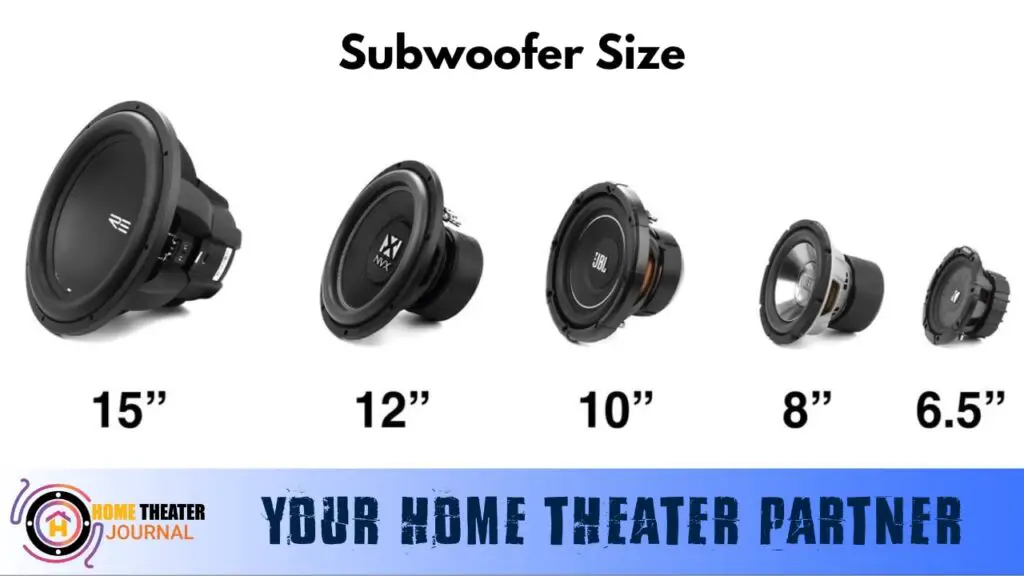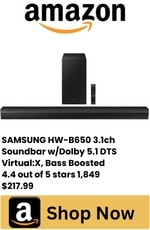How To Choose A Subwoofer | Buying Guide 2025
The best way to choose the right subwoofer depends on various factors, including sound quality and size, power, crossover, and room calibration.
You have to navigate a minefield when buying a subwoofer. A sub the size of a rhinoceros might not be a good fit for your living room if you want the best bass possible. This article explains how you can choose a subwoofer based on sound quality, volume, price, and whether or not you need a wireless subwoofer. Check out our best subwoofers article for our top picks.
Table of Contents
HOW TO CHOOSE A SUBWOOFER
| Factor | Consideration |
| Sound Quality | Dedicated sub improves bass, enhances richness |
| Subwoofer Size | 12″ driver is common, offers balanced bass |
| Power and Volume | RMS wattage matters, higher wattage for more power |
| Wireless vs Wired | Wired offers versatility, better compatibility |
| Frequency Range | Lower frequency better, around 25Hz ideal |
| Front-Firing vs Down-Firing | Both work well, consider placement |
| EQ and Room Calibration | DSP tech improves sound in room environments |
| Ported vs Sealed | Sealed offers controlled sound, ported for power |
| Hi-Fi vs Home Theater | Hi-fi usually requires 1 sub, home theater 2 |
| Cost | $200- The best subwoofer under $1,000 range often provides the best options |
For a comprehensive guide on understanding the role of subwoofers and their significance in your audio setup, check out our blog post on what does a subwoofer do?
Sound Quality
A subwoofer’s primary purpose is to increase bass, so it’s always a big question: will it do that? You can improve your bass with a dedicated sub, regardless of how much you spend.
There will be a lot more meat to it, more richness, and more depth to it. Both movies and music benefit from subwoofers because they boost the low end.
When choosing a subwoofer, however, you’ll find out one important thing nobody tells you. As important as it is, sound quality is only one of the essential factors in choosing a podcast.
Alternatively, we recommend you spend a lot of money on the most extravagant, loudest, and largest subwoofer you can find. One of the main things to remember is that you need to consider factors such as size, power output, frequency, etc.
It is not just about having the best bass; it is about having the right balance of sound quality at this point rather than having just the best bass.
Subwoofer Size

When it comes to subwoofers, size matters; depending on the size of your driver, you’ll be able to achieve a wide range and quality of bass. Subwoofer drivers are basically speakers – circular cones that produce sound.
As a result of the energy required to move bass frequencies through the air, it is not easy to do. Larger drivers will be able to put out more power than smaller drivers, which will, in turn, require a larger cabinet to accommodate the output. There is a question of how big it is.
Subwoofers are different, but there’s a good guideline here about how long they should be. You want to install a home theater or hi-fi system in an average-size room, between 150 and 230 square feet. A 12″ driver is the best choice for a subwoofer.
There are a number of different sizes of drivers available, and this is likely to be the most common one, but it is also likely to be the most forgiving – both in terms of price and in terms of results.
This generator will provide enough power to meet your needs without breaking the bank. The top subwoofer we recommend is the ELAC Debut 2.0 SUB3010 10”($451.60 on Amazon), which has a 10-inch driver, as do many other subwoofers we like.
While you can try subwoofers of any size, 12″ is a great starting point if you’re new to the world of subwoofers.
| Subwoofer Size | Recommended Room Size |
|---|---|
| 6.5 inches | Small rooms up to 1,000 cubic feet |
| 8 inches | Small to medium rooms up to 1,500 cubic feet |
| 10 inches | Medium rooms up to 3,000 cubic feet |
| 12 inches | Medium to large rooms up to 5,000 cubic feet |
| 15 inches | Large rooms exceeding 5,000 cubic feet |
These estimations are based on general guidelines and might vary depending on the subwoofer’s specifications and the acoustic properties of the room.
Power and Volume
A subwoofer with its internal amplifier is usually active, meaning it doesn’t require an external one. Subwoofers are powered by internal amplifiers, which are the device’s core. Choosing a good subwoofer requires understanding how power is measured in watts.
It is usually stated on the specs of subwoofers how many watts they produce at peak and at RMS. The peak can be ignored for all practical purposes. If you crank up a subwoofer to its maximum power, it will produce maximum power. Considering your ears are among the most important parts of your body, it would be unfair to expect you to perform that act frequently. The RMS wattage is the one that will give you the most information.
Please understand that Root Mean Square, or RMS, is sometimes referred to as continuous wattage, which is short for Root Mean Square – but does not make us explain the math. When a subwoofer is driven at a reasonable volume for a period of time, you can get an idea of what kind of power it can produce when driven at a reasonable volume.
In this case, let me give you an example of an inexpensive speaker that gives you fantastic sound for under $150, the Monoprice 9723. The unit has an RMS power consumption of 150 watts, which is typical for this range of prices and plenty powerful for most people to use without any problems.
Wattage does not equal volume, which is one of the most important things to remember.
Subwoofers can always be turned down, no matter how powerful they are. The wattage figure should limit how hard a subwoofer can be pushed. Generally, the higher the wattage output, the more likely it is to play sound at higher levels that is clear, distortion-free, and free from noise and noise.
A higher wattage number will cost you more, so you should consider that. Most people will be satisfied with a wattage of 150-500 watts, which balances the amount of power output with an affordable price, which most individuals will find perfectly acceptable.
Wireless vs Wired Subwoofers

Most subwoofers must be connected directly to your amplifier and to a wall outlet to receive power. Power cables are used for the former, while RCA cables are used for the latter, usually included with subwoofers. Is it possible to go entirely wireless?
You can purchase a wireless subwoofer for $699 at Sonos. These devices work well with their audio sources when they are connected via Bluetooth or Wi-Fi. Companies like VIZIO and the Sonos Sub frequently make wireless subwoofers that connect directly to soundbars.
You may not want to invest time in wireless subwoofers despite our praise. A single wire keeps your subwoofer from connecting to your amplifier, so you’re paying extra for simple things.
The second problem is that most wireless subwoofers operate within an ecosystem closed to the outside world. Sonos subwoofers work only with other Sonos products, so a sub like what I mentioned above can only be used with another. Later, if you upgrade your system, you won’t be able to use it.
A regular wired subwoofer is better if you intend to use speakers from multiple brands in your system. Ultimately, you’ll save money and get better sound quality. There is a place for wireless subwoofers, but they offer little versatility compared to their wired counterparts.
Frequency Range
It is essential to understand that every sound has a frequency – how high or low it is. Understanding frequency is essential for subwoofers, as frequency is measured in Hertz (Hz). Due to the characteristic of low-frequency bass notes, subwoofers that can reach the lowest possible frequency are considered outstanding subwoofers.
We know that humans have a hearing range of about 20Hz and a feeling range of about 10Hz, which is the range that rumbles your stomach when you hear something.
A subwoofer’s performance will be enhanced if it can get close to these targets. Some very expensive subwoofers can reach a depth of 16Hz, like the $2,000 Power Sound Audio S3611. A good subwoofer should reach a frequency of 25Hz, although if a bass isn’t what you want, you can settle for a 50Hz subwoofer. You’ll have to pay more if you’re looking for a subwoofer with a lower frequency floor.
Note the highest frequency your subwoofer can generate when setting it up. Subwoofers begin to produce sound at this point, known as the crossover.
It’s possible to manually set the crossover on most A/V receivers, guaranteeing better bass sound. Some hi-fi amplifiers have this feature, but we have yet to see it on a lot of them.
Front-Firing vs Down-Firing Subwoofers

There is a forward-facing main driver on a front-firing subwoofer. Down-firing subwoofers have their drivers mounted under the floor, facing down. You can choose one based on where you plan to place your subwoofer as there are very minimal differences between them.
You should invest in a front-firing subwoofer if it will be near the main speakers. Both are equally good choices, but you don’t have to choose one.
Ensure you get a subwoofer with passive radiators to enhance your bass performance even more. Subwoofers with these vehicles can carry more bass overall because they are not powered and point out on the sides.
Investing in a subwoofer with these features will cost you some extra money, but it’s ultimately worth it.
EQ and Room Calibration
Sound can uniquely respond to its environment more than any other type. It collects in corners and becomes muddy and indistinct when it encounters a room that could be better due to its slow, heavy nature.
DSP technology (Digital Signal Path) is a technology that subwoofer manufacturers know about. Subwoofers operate in a way that improves and alters the sound before it is pushed out of them, thereby interacting better with the room.
In general, DSP comes in two forms. EQ stands for Equalizer, a tool that allows you to boost or cut certain frequencies within a sound by adjusting its amplitude. Some subwoofers come with this kind of feature, which is usually adjustable over the phone, as it is on this $999 SVS SB-3000 subwoofer.
Choosing presets for EQs is a great way to start if you’re unfamiliar with how to adjust them – no worries. The room calibration may not be necessary because you don’t need to mess with anything in that area.
During room calibration, a series of test tones are played through a microphone attached to a subwoofer. The subwoofer can adjust itself to fit the tones bouncing through the room, thanks to the microphone recording those tones as they bounce around.
A significant boost in clarity and realism can be seen with this technology. It is almost certain that these upgrades will cost you more. For the most part, people don’t need them. A subwoofer under $500 is unlikely to have this feature if you want to get the most bass out of it.
Ported vs Sealed Subwoofers

Subwoofers are very strange when it comes to holes: they have a higher probability of having holes if they are more expensive. As the name implies, subwoofers with ported ports directly connect to the chamber interior through one or more ports.
Ports are absent from sealed subwoofers. The majority of subwoofers on our list of the best available right now are sealed subwoofers, generally speaking, the best models on the market at the moment.
It is the sound quality that distinguishes seal subwoofers from ported subwoofers. The sealed subwoofers usually produce tight, even, controlled sound, while the ported subwoofers can produce large amounts of sound.
Subwoofers with ports are not needed for small audio or home theater setups. You should consider a port-equipped one if you have a large room or want to spend a lot of money.
Hi-Fi vs Home Theater
The versatility of subwoofers makes them ideal for playing music, watching movies, and playing video games. A significant difference between a subwoofer for a hi-fi system and a subwoofer for a music system is that you usually don’t need to buy more than one subwoofer for an audio system.
This isn’t just because one subwoofer will be sufficient for music – that’s for sure. However, the main reason is that most stereo amps cannot send sound from one subwoofer to another subwoofer because they cannot do so.
There is a difference between home theater and regular television. Surround sound systems often require two subwoofers to be played at once through A/V receivers, so this makes sense.
Adding two subwoofers, the power doubles, and the sensation is the same that everyone who likes bass lusts over. There is a certain sensation associated with an engulfing bass hitting you right in the stomach as it comes from all angles, enveloping you completely.
There are a lot of factors that can influence the sound quality of two subwoofers. Still, if you don’t mind experimenting and have a reasonable budget, you can achieve some fantastic results.
Cost of Subwoofers
If you plan on buying a subwoofer, you should spend at least $100. Several other price points have been heard as well, with mixed results. Subwoofers can be purchased for as little as $140, and if you spend a little more, you’ll often see fantastic results. Some real gems are in the $200-$1,000 price range, but many options are available.
Subwoofers are expensive. However, you’re paying more for power and output wattage when you’re over $2,000. Purchasing a subwoofer over $2,000 is unnecessary unless you have a massive room and an equally huge system. The chances of auditioning subwoofers at high-end audio stores are getting increasingly rare, so we recommend shopping online for them.
Conclusion:
Choosing the right subwoofer involves carefully balancing factors to achieve optimal sound quality and bass performance. From considering the size of the driver to understanding wattage and frequency range, each aspect contributes to creating a satisfying audio experience.
Room calibration, subwoofer type, and cost considerations further guide your decision-making. Finding a subwoofer that aligns with your preferences and budget will enhance your audio setup and immerse you in a powerful and rich bass world.
FAQs:
1. What size subwoofer driver is recommended?
A common and balanced starting point is a 12″ driver. It provides sufficient power output without compromising sound quality and is generally forgiving in terms of price.
2. How does wattage relate to subwoofer volume?
Wattage isn’t a direct indicator of volume but represents the limit at which a subwoofer can be driven without distortion. Balanced wattage, usually between 150-500 watts, offers clear and distortion-free sound.
3. Are wireless subwoofers a good choice?
Wireless subwoofers can limit compatibility and tend to work within closed ecosystems. Wired subwoofers offer more versatility and often better sound quality, making them a better choice for most setups.
4. What is the significance of frequency range?
A subwoofer’s frequency range indicates the low frequencies it can reproduce. Optimal subwoofers can reach frequencies around 25Hz, delivering a satisfying bass experience, especially for movies and music.
5. How do EQ and room calibration affect subwoofer performance?
EQ allows adjusting frequency levels for optimal sound quality, while room calibration, utilizing DSP technology, tailors the subwoofer’s output to the room’s acoustics, improving clarity and realism in the sound.

Author: Baqarrasheed
I know all about home theater items! I have been doing this for more than three years now. I am good with things like sound systems, TVs, projectors, and all that cool entertainment gear. I like to help folks by testing and talking about these gadgets on Hometheaterjournal. I want to make sure everyone can create an awesome entertainment setup at home without any confusion.
I write the creative content for HometheaterJournal.






















